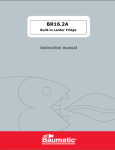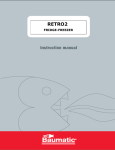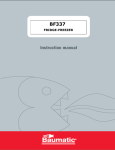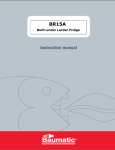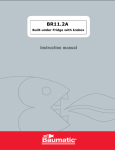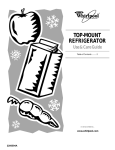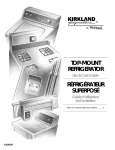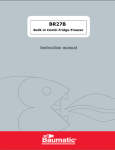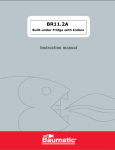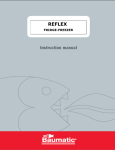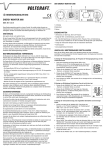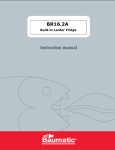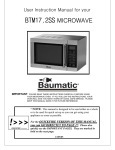Download Baumatic BR22 User manual
Transcript
BR22/8 Built-in Combi Fridge-Freezer User Manual for your BR22/8 BUILT-IN COMBI FRIDGE/FREEZER NOTE: This User Instruction Manual contains important information, including safety & installation points, which will enable you to get the most out of your appliance. Please keep it in a safe place so that it is easily available for future reference. 1 CONTENTS YOUR APPLIANCE’S SPECIFICATIONS …….…….3 SAFETY INFORMATION / ENVIRONMENTAL NOTE .. 4 USING YOUR FRIDGE……………….……………..………5-19 YOUR BR22/8 FRIDGE …………………….………………….5 BEFORE USING YOUR FRIDGE…………….……………..…6 USING YOUR FRIDGE……………..…………………………7-8 STORAGE GUIDE FOR YOUR FRIDGE-FREEZER ..…9-15 CLEANING AND MAINTENANCE……….………………16-17 DEFROSTING ………………………………..………………18-19 INSTALLING YOUR FRIDGE-FREEZER .……………...….20 FITTING THE DÉCOR DOOR ……………………………23-24 LEVELLING YOUR FRIDGE TO YOUR FLOOR …………..25 HOW TO REVERSE THE DOOR SWING ………………26-28 TROUBLESHOOTING ………………………………….29-30 CONDITIONS OF GUARANTEE……………………….………31 CONTACT DETAILS……………………………………………..32 HT mod 01/03/06 2 Specifications of your BR22/8 Built-In Fridge with Icebox Congratulations on purchasing a Baumatic BR22/8 Built-in Combi Fridge/Freezer! Your Fridge has: Â Â Â Â Â Â Â Â Â Â Â Â Â Â Â Â Gross capacity: 280 litres Net capacity (fridge/freezer) 176/69 litres Energy efficiency class: A Star rating: **** Automatic Fridge Defrost Adjustable Thermostat Fast freeze Switch 4 Safety glass fridge shelves 2 Salad Crispers Egg rack 2 Butter Compartments 2 Freezer Drawers Bottle rack Reversible doors 2 General racks 1 Freezer compartment Dimensions mm (H x W x D) 1775 x 540 x 545 To fully enjoy using your appliance long into the future, please firstly familiarise yourself with the specifications, safety advice and operational instructions included in this manual. NOTE: When you install your Fridge-Freezer, it is important to bear in mind its climatic rating. In order to find out the climatic rating of your appliance, check the data rating tag inside your refrigerator. It indicates the ambient temperature range within which your appliance will function. 3 Important Safety Information: Please Read this before installing & using. ELECTRICAL SAFETY • • • NOTE - This appliance must be grounded. In the event of a malfunction or breakdown, grounding will reduce the risk of electric shock by providing a path of least resistance of electrical current. You will be able to tell if it is because a non-grounded appliance will give off an electrical discharge. Manufacturer declines all responsibility for any damage due to nongrounding of appliance. DURING THE GUARANTEE PERIOD ONLY BAUMATIC SERVICE ENGINEERS OR AN AUTHORISED AGENT OF BAUMATIC SHOULD CARRY OUT REPAIRS ON THIS UNIT. DO NOT USE IF THE SUPPLY CORD IS DAMAGED. NEVER TAKE RISKS WITH FIRE! ENSURE YOU CONNECT THIS APPLIANCE TO A SUPPLY RATED AT 220-240V (or 200-230V) and 50HZ. NOTE: the supporting structure is constructed in panels of treated sheet steel, electrostatically enamelled to resist ill-treatment and to give long-lasting beauty and shine. :Do not attempt to alter the specifications of this appliance. Doing so could damage the machine, cause injury & invalidate your warranty. DO NOT USE ADAPTERS/SHUNTS. :Do not allow children to play with, near or inside this appliance. :Do not pull on the power supply cable to free the plug from the wall! :Do not attempt to use your appliance outdoors or any place where it is likely to come into contact with the elements. :Do not pull out or insert the plug with wet hands. :Before any cleaning or maintenance work, ensure that the appliance has been disconnected from the power supply. :Never allow the back coils of the Appliance to come into contact with any wall surface. ALWAYS ENSURE THAT THE SPACE INTO WHICH YOU ARE PLACING YOUR APPLIANCE IS FREE OF STORED ITEMS SUCH AS PAPERS OR OTHER FLAMMABLE MATERIALS. :NEVER block the VENTILATION OPENINGS OF THE APPLIANCE EITHER INSIDE OR ON ITS EXTERIOR. IT IS VITAL TO KEEP YOUR APPLIANCE WELL VENTILATED SO THAT THERE IS PROPER AIR FLOW BETWEEN THE BOTTOM OF THE UNIT AND THE PLINTH / KICK PLATE ON WHICH IT IS SITTING. :WARNING – DO NOT DAMAGE THE REFRIGERANT CIRCUIT. AT THE END OF THE FUNCTIONAL LIFE OF THE EQUIPMENT (WHICH USES COOLING GAS R600o [ISOBUTANE]) AND INFLAMMABLE GAS INSIDE THE INSULATING FOAM, IT MUST BE PLACED IN SAFETY BEFORE SENDING IT FOR PROPER WASTE DISPOSAL. PLEASE OBSERVE ALL INSTALLATION ADVICE IN THIS MANUAL FOR SAFE USAGE OF YOUR APPLIANCE. Note: Before discarding an old refrigerator/freezer, switch off and disconnect it from the power supply. Cut off and render any plug useless. Ensure that the door cannot jam (removing it is best), regardless of whether or not it can be pushed open from inside. AN OLD FRIDGE/FREEZER CAN BE A DEADLY PLAYTHING FOR CHILDREN! CONFORMITY TO W.E.E.E. DIRECTIVE 4 Using your Baumatic BR22/8 FRIDGE-FREEZER Your BR22/8 Built-in Combi Fridge / Freezer: A 1 SHELF: The shelves may be placed in any of the guide slots in the appliance. They are protected from sliding out. To remove a shelf, simply lift the front of the shelf and carefully pull it out of the grooves. Quickly perishable food should be stored at the back (the coldest part of your refrigerator) but not touching the back wall. 2 DEFROST WATER OUTLET The interior of the fridge is cooled with the cooling plate at the rear wall. Beneath this, there is a channel and an outlet for defrosted water. Never let this channel become clogged. Use a plastic straw to clear away any dirt. 3 CRISPER TRAYS & SERVING TRAY The crisper trays at the bottom of your refrigerator are covered to protect fruit and vegetables stored within from drying out. Note that the door liner holds various shelves containing holders for storing eggs, cheese, butter and yoghourt, as well as smaller packages, tubes, cans, etc. The lower shelf is used for storing bottles. B 4 FREEZING COMPARTMENT Is used for freezing fresh foods. 5 STORING COMPARTMENT Is used for storing packets of frozen food. 6 DEFROST WATER OUTLET (See Cleaning & Maintenance) 5 NOTE: BEFORE Using your BR22/8 FRIDGE-FREEZER: UPON DELIVERY: When your Fridge-Freezer has been delivered, you will need to wait approximately 3 hours before turning it on. The fluid of the compressor installed in the appliance will need time to settle. PLEASE DO NOT PLUG IN ANY EARLIER THAN THIS! NOTE: THERE CAN BE AN ODOUR WHEN YOU FIRST SWITCH ON THE APPLIANCE. IT WILL VANISH WHEN THE UNIT STARTS COOLING. We recommend that you have the Fridge-Freezer delivered near to where you plan to install it so that this fluid can settle. SITUATING YOUR FRIDGE CAUTION: DO NOT PLACE THE APPLIANCE NEAR HEAT SOURCES AND FOLLOW THE INSTALLATION ADVICE SHOWN ON PAGE 20. FOR FULL INSTALLATION ADVICE, PLEASE SEE PAGE 20 MAKE A NOTE OF THE LOCATION FOR YOUR NEW FRIDGE-FREEZER. MAKE SURE THAT IT WILL FIT PROPERLY SO THAT: 1) The doors can open freely and completely. 2) You can access your food conveniently. 3) There is sufficient space (38mm) at the back for the cooling coils to give off heat safely & that they do not touch the plug (see SAFETY SECTION). NOTE: You can reverse the swing of the door to customise the unit to your location. Please see pages 24-26 for details. 6 NOTES ON USING your Baumatic BR22/8 FRIDGE-FREEZER YOU SWITCH ON YOUR APPLIANCE by PLUGGING IT IN & SETTING THE THERMOSTAT inside the Fridge at the upper righthand side: Your Fridge-Freezer’s thermostat automatically regulates the inside temperature of the compartments. By rotating the thermostat knob from a low to a higher number position, colder temperatures can be obtained. Fridge-Freezer Thermostat setting Note: Turning the knob setting towards 7 will make all the compartments of your fridge-freezer colder. Because the interior fridge temperature may dip below 0°C, you should NOT leave your fridge on the maximum setting for long periods. Settings 3-5: Use these midsettings for longer storage of food in the fridge = midcoldness. Settings below this will give a milder coldness to the interior of the fridge. 0: This setting will make the fridge STOP (the cool system is deactivated), although the light will still function. REMINDER: On the maximum setting, your fridge will work harder to maintain this low temperature. So, after you reach this temperature, you should turn the knob to a milder setting (depending on long or shortterm storage intentions). ONLY USE THE FAST FREEZE SWITCH FOR SHORT BURSTS OF COLDNESS – NEVER LEAVE IT ON PERMANENTLY. 7 NOTES ON USING your Baumatic BR22/8 FRIDGE-FREEZER Reminder: Allow the unit time to settle after delivery. If your plug and power socket are now behind the fridge and you still need to move the unit into place, be especially careful. Remember to leave a safe distance between the back of the fridge and the wall behind it. YOU WILL NEED TO REMOVE THE BACK WALL OF THE UNIT CABINET INTO WHICH THE APPLIANCE IS TO BE INSTALLED. o You switch your fridge OFF by turning the thermostat knob to position ‘0’. NOTE: When you first switch on the appliance, allow 24 hours for it to cool down to the desired temperature. During this time, DO NOT open the door often or place a lot of food inside the unit. WARNING! If the appliance is switched off then switched back on again after a short period, the compressor will start up again after approximately half-an-hour. This is part of the normal operation of the appliance. 8 ARRANGING FOOD IN YOUR FRIDGE-FREEZER MAKING ICE CUBES Pour water into the Ice cube tray. Fill to ¾ full in each cell of the tray then place the tray in the topmost shelf of the freezer compartment. Do not use a knife or other metal tools to take ice out of the tray once ice has been made. Ice can easily be removed by hand after the tray has been placed in warm water for a short time. • To reduce humidity inside your fridge-freezer, NEVER place liquids in unsealed containers in the refrigerator. Always dry off wet items before placing them in the appliance. • • Make sure that you arrange food in such a way that the door can close completely. Be especially wary of protruding items (such as bottles) between shelves and the inside of the door. • NEVER place warm food inside your refrigerator or freezer. Warm food must be allowed to cool at room temperature first. It should then be arranged to ensure adequate air circulation in the refrigerator compartment. If freezing, see page 14 for tips. • Crispy / delicate foods should be stored in the coldest parts of the fridge. • DO NOT open the refrigerator door too often or leave it open for long spells of time. 9 ARRANGING FOOD IN YOUR FRIDGE-FREEZER • ARRANGE meat and cleaned fish (wrapped in packages or sheets of plastic) which you will then use within 1-2 days. • You can put fruits and vegetables into the crisper without leaving them in their packaging. • Unpleasant odours within may mean your fridge needs cleaning or that food has spoiled. • If you are planning on being away from your refrigerator for a few days (such as going on holiday), make sure that you remove quickly perishable articles of food from your fridge before you go and dispose of them. • Always be mindful of the storage life of foods you are going to be freezing for a long time. Although the temperature of the freezer can dip to a very low level this does not mean that food can be stored indefinitely. Pay particular attention to the information printed on the packaging of the foods you are going to be placing in your freezer. • You should seal your food in suitable storage bags before placing them in the refrigerator or freezer. Label freezer • bags appropriately. Always store food with a view to how often it will be used. Food consumed daily should be placed in the most convenient area so that you don’t end up leaving the door open 10 ARRANGING FOOD IN YOUR FRIDGE-FREEZER for long periods while you search for food. • Do NOT store excess quantities or weights of food. Always try to leave gaps between your packages for better • storage results. • Do not place food too closely to the interior walls – items put too close to the walls may freeze to them! • If you place vegetables with their stalks or roots facing towards the cold source, you will be able to store them for longer. • The leaves on carrots, turnips, etc. should be removed before you store them. • Always store eggs vertically in the egg holder provided in the door. Onions, garlic, ginger and other root vegetables should not be stored in the refrigerator as these types of food can be stored appropriately at room temperature. 9 NOTES ON USING YOUR FRIDGE-FREEZER • Ripe squashes, melon, pawpaw, bananas and pineapples should not be stored in the refrigerator. Colder temperatures accelerate the ripening process. ALWAYS Cover and wrap foods, especially if they are PUNGENT. DO NOT place paper or plastic on the shelves which would block the flow of air through the grids. NOTE: At the maximum cold setting, with a high outside (ambient) temperature and well-stocked (full or nearly full) compartments, the Fridge’s operation may be continuous. If your appliance has taken in an unusually high amount of moisture, some ice deposits may temporarily form inside, on the evaporator. REMINDER: You should regulate the temperature of your Fridge bearing the following in mind: o o o o o Ambient temperature How often the doors are opened and closed Quantity of food stored in the compartments Moisture content of what you place in your fridge The location of your appliance IN CASE OF A BLACKOUT (GENERAL POWER FAILURE) In case of Power Failure, find out how long the electricity will be off. If the failure is not going to be for any longer than 12 hours, leave the food in the freezer and keep the door closed. If the POWER FAILURE is going to last longer than 12 hours and some food defrosts, consume the latter as soon as possible. LONG ABSENCES (holidays, etc.): In the case of long absences, your appliance must be switched off, emptied out completely, dried and the doors left open to prevent the formation of mould and unpleasant odours. 12 STORAGE GUIDE FOR YOUR FRIDGE-FREEZER The charts below are approximate guidelines only. STORING FOOD IN YOUR REFRIGERATOR Remember to store food properly, observing advice on the packaging. 13 STORING FOOD IN YOUR FREEZER Fresh foods – Foods to be stored in the freezer should be in good edible condition and suitable for freezing BEFORE they are put into the freezer. NOTE: When buying commercially available frozen food, make sure that the packaging is neither sodden nor covered with frost (snow) before you place it in the freezer at home. ¾ Use correct packaging and wrap items correctly. ¾ The packaging should be airtight and shouldn’t leak since this could cause substantial vitamin loss and dehydration from your food. ¾ Foil and bags should be applied carefully to articles of food so that they can be stored systematically & comfortably within the freezer. ¾ Mark your packages with data such as: the type and amount of food inside the package, and the date on which it was prepared and loaded into the freezer. Defrosting Frozen Food – Partially thawed or defrosted food should be used as soon as possible. Defrosted food cannot be put back in the freezer unless it has been cooked first. ¾ It is very important that the food is frozen as quickly as possible. We therefore recommend that the size of the package not be too large. It should also be sufficiently cooled (at least to room temperature) before being inserted in the freezer compartment. ¾ The amount of fresh foods that can be loaded into the freezer within 24 hours is indicated on the rating plate (freezing capacity). ¾ Food cut into small portions will freeze faster & be easier to defrost and cook. The recommended weight for each portion is 2.5kg. ¾ The outside of any food packaging should be dry before being placed in the freezer. All packages should be odour-free, airtight & non-toxic. 14 APPROXIMATE STORAGE TIME FOR FROZEN FOODS (Always read the information printed on the packaging of the foods you are about to store in your freezer). NOTE: For fast, intensive freezing, press the Fast Freeze switch. After 24 hours, turn this off as long-term use is not recommended. 15 CLEANING / MAINTENANCE NOTE: Before attempting to clean your appliance, UNPLUG IT and make sure you do the following: WE RECOMMEND THAT YOU CLEAN AND MAINTAIN YOUR REFRIGERATOR ONCE A MONTH. 9 Pay particular attention to the sealing rubber bars of the doors. These need to be kept clean for hygienic reasons as well as to allow the door to close properly. 9 Leave the door open during cleaning. 9 In order to collect the defrosted water, take out the bottom drawer and soak up the water using a sponge as shown in the figure pictured below. To accelerate the defrosting process, you can scrape off any frost that may have formed on the back coils using a plastic spatula. DO NOT USE A METAL ONE!!!! NOTE: You will need to move the appliance forward from its cabinet to access the rear (shown at left) Clean the inside of your Fridge using a solution of soda bicarbonate in warm water (1 tablespoon Bicarbonate to 2 litres of water). 9 Clean the condenser (back of unit) with a broom once a year. 9 NEVER USE SOLVENTS TO CLEAN THE INSIDE OF YOUR REFRIGERATOR. MAINTENANCE FROM TIME TO TIME, YOU WILL NEED TO REPLACE THE INTERNAL BULB. REMEMBER TO UNPLUG YOU APPLIANCE FIRST Find the lamp housing in the top right of the refrigerator’s interior. Gently move the transparent lamp cover plate from the lamp cradle. Unscrew the bulb and replace with a new one, maximum (15W). 16 CLEANING CLEANING//MAINTENANCE MAINTENANCE HOW TO CLEAN THE CONDENSER – NOTE: You will be alerted to the presence of excessive amounts of dust on the condenser by a sound alarm. NOTE: YOU WILL NEED TO MOVE THE APPLIANCE FROM ITS POSITION IN THE UNIT IN ORDER TO ACCESS THE CONDENSER. DO SO WITH CAUTION! Upon hearing this alarm, you should: • Check the air circulation through the bottom rail openings. Your fridge-freezer needs good ventilation at the plinth level at the bottom. • If necessary, clean or vacuum the dust from the condenser. See the instructions BELOW. The condenser consists of the coil structure at the back of the refrigerator. To clean it: 1. 2. 3. Disconnect from the power supply. Move the refrigerator out of its cabinet housing. TAKE EXTREME CARE whilst performing this. The back of the appliance consists of the condenser coils. These must be either dusted lightly or vacuumed. Be careful not to damage them as they are vital to the appliance’s good functioning. After cleaning, move the refrigerator back into place. NOTE – FROM TIME TO TIME, YOU WILL ALSO NEED TO CLEAN THE DRAIN PAN THAT SITS ATOP THE COMPRESOR. Do NOT remove it to clean it. IT LOOKS LIKE THIS (at right): 17 DEFROSTING 1. REFRIGERATOR There is no need to defrost the refrigerator – ice forming on the inner back wall is automatically defrosted. Ice deposits on the inner back wall while the compressor operates. Later on, when the compressor is not operating, ice defrosts and water drops collect and drain through the outlet in the inner back wall into the drain pan situated above the compressor, from where it evaporates. 2. FREEZER You must, however, MANUALLY DEFROST the FREEZER When the frost and ice layer in the freezer is 3-5 mm thick, you should clean the freezer. NOTE – IF YOU SHOULD NOTICE WATER LEAKING FROM YOUR FRIDGE-FREEZER, YOU SHOULD: a) Set the thermostat to position ‘7’ so that packages are well frozen. Reset the thermostat to the ‘STOP (0)’ position and disconnect the power supply. Empty the freezer and take care that the packages remain frozen. b) Insert the enclosed pipe into the groove in the bottom of the appliance and place a vessel underneath to collect the defrosted water. • NOTE: Defrosting is accelerated if the door is left open or if you insert a basin of warm water to speed the process. NEVER USE HAIR DRYERS TO DEFROST WITH. • NEVER USE DEFROSTING SPRAYS. SPRAYS MAY CONTAIN CHEMICALS THAT ARE TOXIC OR CAUSTIC. c) 18 Remove the detachable accessories in the interior of the appliance and clean them with water & liquid detergent. Plastic parts cannot be washed in the washing machine. d) Wash the interior of the appliance with lukewarm water, in which you have added one or two spoonfuls of vinegar. e) Every now and then clean the condenser on the rear wall. Use a soft duster or vacuum cleaner to do this. TIPS FOR ENERGY SAVINGS 9 Try not to open the door too often, especially when the weather is wet and hot. Once you open the door, be sure to close it as soon as possible. 9 Use higher thermostat settings only if essential and not for constant, long-term use. 9 Before loading the appliance with packages of fresh foods, ensure they are cooled to an ambient temperature (except in the case of soup). 9 If the door seal (gasket) is damaged, the energy consumption will be much higher. To keep the sealing in good condition, be sure not to spill oils or fats on it. A damaged seal will need to be replaced. 9 19 The condenser at the bottom of the appliance must always be clean and free of dust. INSTALLING YOUR BR22/8 FRIDGE-FREEZER Your appliance needs 200 cm² of open space beneath it for VENTILATION otherwise it will overheat and malfunction. 17751780mm 17751780mm You need to remove the back of the cabinet unit to allow 200 cm² of open space, also for VENTILATION. You need to leave 4mm of space between each side of the appliance & the interior of the cabinet. NOTE: Ensure that you are going to be placing your fridge away from heat sources and in a well-ventilated position. This should be at least 3 cm away from electric or gas stoves and 30 cm from oil or coal stoves. Do not place the appliance in the path of direct sunlight. Push the appliance into the kitchen unit’s space and allow at least 4mm free space on both sides between the appliance and the side walls of the kitchen unit (see Fig.1, at right) and 38mm between the back of the appliance & the wall at the back of unit. 1) 20 INSTALLING YOUR APPLIANCE- CONTINUED Fitting Bar Install the Fitting Bar (shown in the picture below), so that it attaches to the top of the appliance and underneath the top of the cabinetry, indicated by the arrow: *Please be aware that the Fitting Bar is not attached to the appliance and needs to be secured during installation. 21 INSTALLATION-AMBIENT TEMPERATURE GUIDELINES YOU MUST install this appliance in well ventilated, dry room. Energy use is affected by the ambient temperature. You are therefore advised to: Not expose the appliance to direct sunlight; Not install the appliance next to radiators, cookers or other sources of heat; Only install the appliance at a location whose ambient temperature corresponds to the climate classification, for which the appliance is designed. The climate classification can be found on the data rating tag, which is located at the left on the inside of the appliance. Cooling Temperature Ranges Climate Classification Recommended Ambient Temp. SN +10 to +32° C N +16 to +32° C ST +18 to +38°C T +18 to +43°C If the appliance is installed next to another refrigerator or freezer a clearance of 5 cm at the side is required. This is to prevent the formation of condensation on the outside of the appliance. 22 INSTALLING YOUR BR22/8 FRIDGE-FREEZER Fitting the Décor Door - 1) Using a 3mm diameter bit, make holes sufficient to attach the hinge rail brackets as shown in Fig. 2 on next page. 2) Fix the slide guides (attached in a plastic bag along with the screws ST 4.2 x 9.5) to the edge of the door. Cover the open holes with the attached caps. 3) Hold the appliance door to the décor door (See Fig. 2, at left). 4) Insert the slides into the guides and fix them on the kitchen unit door some 15mm from the edge, using the A 4 x 12 screws (Fig. 3, at right). 5) Remove the slide guides and separate the appliance door from the door of the kitchen unit. 23 INSTALLING YOUR BR22/8 FRIDGE-FREEZER 6) Fix the slides, being careful not to move them while fixing them into place (Fig. 4, at left). 7) Fix the slide guides to the original position. 8) Close the door and check the gasket seal (it should not be creased or crushed). The door should open and close smoothly. FIXING THE APPLIANCE INTO THE KITCHEN UNIT Open the doors and find the holes through which you can fix the appliance to the unit. Attach the appliance to the inside of the unit as shown in Figure 5, below left. (See Figure 5, above left). 1) Taking a drill bit with a diameter of 3mm, make 5 holes as shown in figure 5. 2) On the upper side, fix the three screws A4 x 12 through the rail. 3) On the lower side, fix the two screws A4 x 16 through the lower hinges. 4) Seal the gap on the opposite side of the hinge with the enclosed seal (see Fig. 6). 24 Adjusting the feet to Level your Appliance Adjusting the feet to level your Appliance Adjust the feet (see picture below) until your Fridge sits levelly on your floor. You can level your unit using these adjustable feet to compensate for dips and rises in your floor surface. NOTE: You can adjust feet up to a maximum height. The height MUST be adjusted before the appliance is built into the unit space designated for it. DO NOT MOVE THE FRIDGE WHEN THE FEET ARE EXTENDED HIGH! 25 Reversing the Swing of the Door Reversing the swing of the Door KEY 1. Top hinge cover of the refrigerator door. 2. Top hinge of the refrigerator door. 3. Top strip. 4. Bottom hinge of the refrigerator door. 5. Top hinge of the freezer door. 6. Washer. 7. Bottom hinge of the freezer Door. 8. Bottom hinge filling plug of the freezer door. 9. Slider guide. 10. Corner cap with a hole. 11. Corner cap without a hole. If you find the door opening direction of your appliance to be inconvenient, you can reverse it. The necessary holes on the opposite side of the appliance cabinet have been made in the factory and plugged. 1) Remove the top hinge cover of the refrigerator door. Remove the door by unscrewing the hinge (the door will now be supported only by the bottom hinge) and remove the hinge washer. 2) Unscrew Reversing the top strip.the Move it overof to the the opposite Swing Door side of the appliance and fasten it. 26 3) Unscrew the bottom hinge and washer of the freezer door and remove the lower door. 4) Unscrew the top hinge of the freezer door and the bottom hinge of the refrigerator door. 5) Remove the corner caps from the door and reposition them (instead of the corner cap with a hole, insert the one without a hole, and vice versa). 6) Take off the washer from the bottom hinge of the freezer door (by turning it in clockwise). Unscrew the bottom hinge filling plug and screw in the bottom hinge without a plug. 7) Insert the filling plug and the washer in the reverse order into the hole for the bottom hinge on the opposite side of the appliance. 8) Put the freezer door on the bottom hinge. 9) Turn the bottom hinge of the refrigerator door by 180 degrees. Insert the hinge and the washer into the hole of the corner cap on the freezer door and fasten it. Use the same procedure for the top hinge of the freezer door and screw it on the opposite side of the upper door. Put the washer and the upper door on the hinge. 10) Screw the top hinge of the refrigerator door and replace the cover. 11) Reposition the slide guides on the opposite sides of both doors. 12) Plug the remaining holes with the caps provided. NOTE - After you have reversed the door, check that the magnetic gasket seals correctly. It must not be creased and must seal all around the door. In case it does not fit perfectly, pull it out and rotate for 180 degrees. In certain models it is not possible to replace the door gasket. Should the seal not adhere to the casings of the appliance correctly, it will have to be heated from a suitable distance using a hair dryer and lightly stretched in order to attain the required dimensions. 27 NOTE FOR AFTER REVERSING THE DOOR ¾ After you have reversed the door, check that the magnetic gasket seals correctly. It must NOT be creased or crushed so that there is a gap between it and the inside of the door. It must also seal all around the door. ¾ In case the seal does not fit perfectly, pull it out and rotate it by 180 degrees. ¾ Should the seal not adhere to the casings of the appliance correctly, it will have to be heated from a suitable distance using a hair dryer and lightly stretched in order to attain the required dimensions. Troubleshooting PROBLEM WHAT TO DO 28 CHECK THAT THE PLUG IS WELL-INSERTED INTO THE POWER SOCKET. PLUG IN IF NECESSARY. YOUR FRIDGE DOES NOT APPEAR TO BE WORKING / NO APPARENT POWER CHECK THAT THERE IS POWER FROM THE MAINS – THERE MAY BE A BLACKOUT OR YOUR FUSES MAY HAVE BLOWN. CHECK THAT THE ELECTRONIC THERMOSTAT HASN’T BEEN TURNED ALL THE WAY DOWN TO ‘OFF’. CHECK THAT THE SOCKET IS SUFFICIENT AND NO ADAPTER OR EXTENSION LEADS HAVE BEEN USED. CHECK THAT THE POWER SUPPLY VOLTAGE CORRESPONDS TO THE APPLIANCE. YOU HAVE OVERLOADED THE APPLIANCE OR FOOD HAS BEEN PACKED TOO TIGHTLY. TAKE OUT AND CONSUME FOOD; LOOK FOR OUT-OF-DATE FOOD THAT CAN BE DISPOSED OF. YOUR FRIDGE APPEARS TO BE PERFORMING POORLY THE THERMOSTAT SETTING IS SET TOO LOW. SET IT HIGHER. ENSURE THAT THE DOOR HAS BEEN CLOSED PROPERLY. FOR INSTANCE, THERE MAY BE A PROBLEM INSIDE THE UNIT, KEEPING THE DOOR OPEN OR ANOTHER FAULT, SUCH AS A BROKEN OR MISSING DOOR SEAL. ENSURE THAT THERE IS NO DUST ON THE CONDENSER. ENSURE THAT THERE IS ENOUGH ROOM AT THE REAR AND SIDES OF THE UNIT. THERE IS A NOISE PROBLEM 29 THE COOLING GAS WHICH CIRCULATES MAY MAKE A SLIGHT NOISE (BUBBLING or a SOUND LIKE RUNNING WATER) EVEN WHEN THE COMPRESSOR IS NOT RUNNING. THIS IS NORMAL. IF THESE SOUNDS CHANGE, ENSURE: Troubleshooting YOUR UNIT IS WELL LEVELLED / NOTHING IS TOUCHING THE REAR OF THE UNIT / NO MATERIAL ON THE APPLIANCE IS VIBRATING. WHAT TO DO WATER LEAKS FROM MY APPLIANCE STRANGE ODOUR THE WATER OUTLET IS BLOCKED – CLEAN THE CLOGGED OPENING WITH A STRAW. THERE HAS BEEN SPILLAGE INSIDE THE APPLIANCE. MOP IT UP. FAILURE TO SEAL FOOD PROPERLY – FIND CONTAINER RESPONSIBLE AND SEAL IT PROPERLY. INTERIOR OF REFRIGERATOR IS DIRTY – CLEAN IT. ROTTING FOOD INSIDE REFRIGERATOR – TAKE IT OUT AND DISCARD. THE REFRIGERATOR DOOR HAS BEEN OPENED TOO OFTEN. CONTINUOUS OR LONG OPERATION OF THE COMPRESSOR THE FRIDGE DOOR HAS NOT BEEN CLOSED PROPERLY. TOO MUCH FOOD HAS BEEN LOADED INTO REFRIGERATOR. IMPROPERLY SET THERMOSTAT. FIRST TIME USE. EXCEPTIONALLY HOT WEATHER. FAILURE OF LAMP THE LIGHT BULB HAS BLOWN – CHANGE IT. TRIPPED FUSES OR POWER BLACKOUT. BAUMATIC LTD. -CONDITIONS OF GUARANTEE. Dear Customer, 30 The conditions of guarantee which apply to your Baumatic appliance are as follows: This product is guaranteed for 12 months from the date of original purchase. Baumatic Ltd will repair any defect that arises due to faulty materials or workmanship free of charge during this period. *In addition, your appliance is covered by a 5 year parts warranty. Baumatic Ltd will provide free of charge the parts required to repair the appliance, only if they are fitted by a Baumatic engineer, for any defect that arises due to faulty materials or workmanship within a period of 5 years from the original purchase date. *An additional and annually renewable insurance scheme for labour is available should you wish to extend the warranty period. Should any person other than an authorised representative of Baumatic Ltd interfere with the appliance, the policy is negated and Baumatic Ltd will be under no further liability. The guarantee covers the appliance for normal domestic use only, unless otherwise stated. Any claims made under the terms of the guarantee must be supported by the original invoice/bill of sale issued at the time of purchase. This guarantee is transferable only with the written consent of Baumatic Ltd. If the appliance fails and is considered either not repairable or uneconomical to repair between twelve months and five years from purchase date, a free of charge replacement will not be offered. The guarantee for any replacement will only be for the remainder of the guarantee on the original product purchased. This guarantee does not cover: x Sinks and taps X Failure to comply with the manufacturer’s instructions for use. X The replacement of cosmetic components or accessories. X Accidental damage or wilful abuse. X Subsequent loss or damage owing to the failure of the appliance or electrical supply. X Incorrect installation. X Losses caused by Acts of God, civil war, failure to obtain spare parts, strikes or lockouts. X Filters, fuses, light bulbs, external hoses, damage to bodywork, paintwork, plastic items, covers, baskets, trays, shelves, burner bases, burner caps, decals, corrosion, rubber seals.. In the course of the work carried out it may be necessary to remove the appliance from its operating position. Whilst all reasonable care will be taken, Baumatic Ltd cannot accept responsibility for damage sustained to any property whatsoever in this process. This guarantee is in addition to and does not diminish your statutory or legal rights. Contacting Baumatic. SALES TEL: 0118 933 6900 FAX: 0118 931 0035 SERVICE TEL: 0118 933 6911 FAX: 0118 986 9124 SPARES TEL: 0118 933 6922 FAX: 0118 933 6942 TECHNICAL / ADVICE TEL: 0118 9336933 FAX: 0118 9336942 For mainland UK and Northern Ireland, please contact one of the above numbers for further information or any other query you may have. For ROI (Republic of Ireland), please contact one the numbers below: TEL: 01 - 6266798 FAX: 01 - 6266634 Thank you for buying Baumatic. *Applies to UK, Scotland, Wales & Northern Ireland only. (Republic of Ireland has 1 year labour and 1 year parts warranty only) . 31 Baumatic Ltd Make-up for your kitchen Headquarters Baumatic Ltd. Baumatic Buildings, 6 Bennet Road, Reading, Berkshire RG2 0QX, United Kingdom Sales Telephone +44 118 933 6900 Sales Fax +44 118 931 0035 Service Telephone +44 118 933 6911 Service Fax +44 118 986 9124 Spares Telephone +44 118 933 6922 Technical / Advice Telephone +44 118 933 6933 E-mail: [email protected] [email protected] Http (Internet site): www.baumatic.com 32 33


































